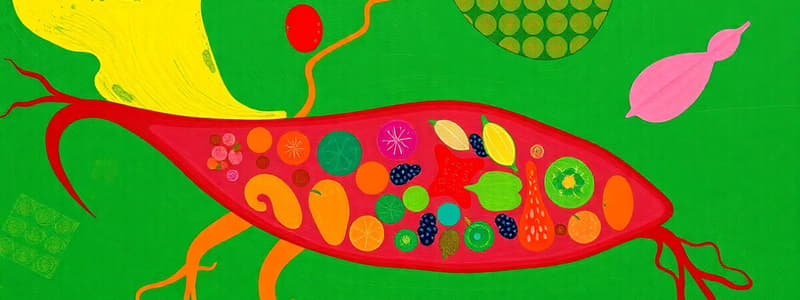Podcast
Questions and Answers
Which of the following correctly describes primary active transport?
Which of the following correctly describes primary active transport?
- It relies on ATP for direct energy use. (correct)
- It requires specific transport proteins for function.
- It transports nutrients along the concentration gradient.
- It facilitates the movement of gases like oxygen.
What is the primary function of secondary active transport?
What is the primary function of secondary active transport?
- To facilitate simple diffusion of nutrients.
- To maintain osmotic balance without energy.
- To utilize energy from primary transport processes. (correct)
- To generate ATP for energy needs.
Which factor does NOT directly affect the rate of nutrient uptake?
Which factor does NOT directly affect the rate of nutrient uptake?
- Plant species. (correct)
- Presence of transport proteins.
- Soil type.
- Concentration gradient.
How does passive transport differ from active transport in terms of energy requirements?
How does passive transport differ from active transport in terms of energy requirements?
What role do membranes play in nutrient uptake?
What role do membranes play in nutrient uptake?
Which statement is true regarding facilitated diffusion?
Which statement is true regarding facilitated diffusion?
In terms of uptake rates, how do active and passive transport compare?
In terms of uptake rates, how do active and passive transport compare?
Which type of molecule is most likely to pass through the cell membrane via simple diffusion?
Which type of molecule is most likely to pass through the cell membrane via simple diffusion?
Flashcards are hidden until you start studying
Study Notes
Primary Active Transport
- Moves molecules against their concentration gradient, meaning from a region of lower concentration to a region of higher concentration.
- Requires energy, often in the form of ATP, to move substances uphill.
- Uses transmembrane proteins to pump molecules across the membrane.
Secondary Active Transport
- Uses the energy stored in the electrochemical gradient of another molecule to move a substance against its concentration gradient.
- Relies on the movement of a substance down its concentration gradient to provide energy for the uphill movement of another substance.
- Primary function is to transport molecules against their concentration gradient.
Factors Affecting Nutrient Uptake
- Concentration Gradient: The difference in concentration of a nutrient between the outside and inside of a cell.
- Membrane Permeability: The ease with which a nutrient can cross the cell membrane
- Temperature: A higher temperature generally increases the rate of diffusion.
- Surface Area: A larger surface area provides more space for nutrient uptake.
- Carrier Protein Availability: Limited availability of carrier proteins can restrict uptake rates.
Passive Transport vs. Active Transport
- Passive transport: Does not require energy, as molecules move down their concentration gradient from a region of high concentration to a region of low concentration.
- Active transport: Requires energy to move molecules against their concentration gradient, from a region of low concentration to a region of higher concentration.
Membranes in Nutrient Uptake
- Act as selective barriers, controlling the passage of molecules into and out of the cell.
- Possess transport proteins that facilitate the movement of specific nutrients across the membrane.
Facilitated Diffusion
- A type of passive transport that uses transport proteins to facilitate the movement of molecules across the membrane
- Still relies on the concentration gradient, but the transport protein speeds up the process.
- Doesn't require energy expenditure by the cell.
Active vs. Passive Transport Rates
- Active transport: Can achieve higher uptake rates, as it can accumulate nutrients against their concentration gradient
- Passive transport: Rates are limited by the concentration gradient and may be slower, especially when concentrations are low.
Simple Diffusion
- Small, non-polar molecules are most likely to pass through the cell membrane via simple diffusion.
- Examples of these molecules include oxygen, carbon dioxide, and some lipids.
Studying That Suits You
Use AI to generate personalized quizzes and flashcards to suit your learning preferences.




